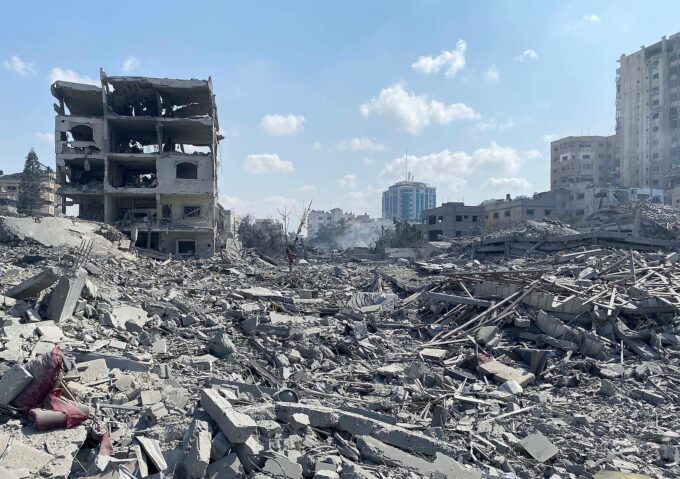Israeli Treatment of Palestinians Remains Unchanged Over 75 Years

Netzah Yehuda training exercise. Photograph Source: יעסיעס – CC BY-SA 4.0
The Biden administration’s decision to continue funding the notorious Netzah Yehuda battalion, an ultra-Orthodox unit that operates on the West Bank, is the latest indication that the United States is unwilling to take any steps to counter Israel’s genocidal campaign against the Palestinians. The funding of the battalion marks a major defeat for the human rights experts in the Departments of State and Defense, who argued that Netzah Yehuda should be barred from receiving U.S. support. This marks one more decision by Secretary of State Antony Blinken that ignores the need for accountability with regard to the barbarous actions of the Israeli Defense Forces.
The Netzah Yehuda battalion is particularly violent in dealing with the Palestinian community. The battallion has killed unarmed civilians and suspects in custody as well as committed sexual assault and torture. it has attracted many members of an extreme religious-nationalist settler group infamous for establishing illegal outposts on Palestinian land that have no legal basis in Israeli law. In recent years, the Netzah Yehuda battalion has been involved in at least a half-dozen controversial cases involving its soldiers, resulting in jail time, discharge, or harsh criticism for assaulting or killing innocent Palestinians.
U.S. funding of the battalion is a violation of the Leahy Law, passed in 1997, that prohibits the Departments of State and Defense from providing military assistance to foreign security force units that violate human rights. U.S. embassies and the appropriate regional bureaus of the Department of State vet potential recipients of security assistance. If a unit is found to have been credibly implicated in a serious abuse of human rights, assistance is denied until the host nation government takes effective steps to bring the responsible persons within the unit to justice. As a result, security forces and national defense units in Bangladesh, Bolivia, Columbia, Guatemala, and Mexico have been denied assistance in the past. The United States, of course, plays by different rules when it comes to military support for Israel.
Even before Blinken made his unfortunate decision regarding the battalion, Prime Minister Benjamin Netanyahu obnoxiously proclaimed that “if anyone thinks they can impose sanctions on a unit of the IDF—I will fight it with all my strength.” U.S. presidents have been unwilling to stand up to Netanyahu who has led six of the eleven different Israeli governments over the past 28 years. This funding decision is particularly reprehensible because the battalion was responsible for the death of a 78-year-old American citizen whose stress-induced heart attack was brought on by being bound, gagged, and left on the ground by Israeli forces. Netanyahu’s government prosecuted no one in this case.
One of the more feckless U.S. moves regarding the war in Gaza was President Biden’s decision to deliver humanitarian aid to the Palestinians via a floating military pier. U.S. officials in the Departments of State and Defense argued that the weather conditions in the Mediterranean would compromise any effort to make the pier workable. The critics were right. They wanted the Biden administration to put pressure on Israel to open land crossings for aid, but Biden refused to do so. As a result, the pier was attached to Gaza’s coast line in May and abandoned in July.
Israeli officials maintain that they are allowing aid into Gaza, but the aid is going in slowly and humanitarian conveys are still being attacked. A UN vehicle, clearly marked, was attacked several days ago and Palestinian aid workers were killed. Meanwhile, more than 560 schools in Gaza have been hit or destroyed, and numerous shelters have been attacked. This points to the moral squalor of Israeli public declarations that deny the targeting of humanitarian missions.
In order to understand the Arab-Israeli conflict (and perhaps appreciate U.S. complicity), it helps to remember the first Israeli edicts against its Palestinian population more than 75 years ago. With the creation of the state of Israel, the Knesset adopted the British Defense Regulations that enabled Israeli military authorities to close off the Arab areas and restrict entry and exit only to those with permits. Every Arab inhabitant had to apply to the military government office or to the police in his/her district to obtain a permit to leave his/her village for whatever reason.
The Knesset added its own restrictions to the British regulations. These enabled the Israelis to deport people from their towns or villages and to summon any person to present himself at a police station or to remain confined to his/her house. Any Arab could be placed under administrative arrest for an unlimited time, without explanation and without trial. Violators were tried by military courts and not civilian ones; this is still true today on the West Bank. Tom Segev, one of Israel’s most distinguished historians, noted in his important book, “1949: The First Israelis,” that “among the soldiers and officers sent to rule over the Arabs were ones who had been found unfit for active service.” They were vengeful, which is true today on the West Bank. Segev is associated with Israel’s New Historians, a group challenging many of the country’s traditional narratives.
Another distinguished Israeli historian, Ilan Pappe, recorded in his book, “Ten Myths About Israel,” that the discussion of the forced transfer of the Arab population in Palestine began even before Israel received its independence in 1948. The discussions evolved into a master plan for the massive expulsion of Palestinians, which was known as Plan Delat. Pappe notes that the Israeli Foreign Ministry created the myth that the Palestinians became refugees because their leaders told them to leave Palestine before the “Arab armies invaded and kicked out the Jews.”
Beyond Bombs and Bullets: The Full Tally of
Gaza’s Dead

Photograph Source: WAFA (Q2915969) – CC BY-SA 3.0
Israel’s assault on Gaza has now officially surpassed the gruesome milestone of 40,000 Palestinians dead, but in counting only those killed in direct acts of violence that number captures just a fraction of the human loss.
“Most civilian casualties in war are not the result of direct exposure to bombs and bullets,” noted a 2017 studypublished by the American Academy of Arts and Sciences, “they are due to the destruction of the essentials of daily living, including food, water, shelter, and health care.”
This broader understanding of conflict casualties was applied to Gaza in a July study published in The Lancet, one of the world’s premier medical journals. The study found that at that time, it was plausible to assume that Israel’s military campaign would be responsible for the deaths of some 186,000 people.
To calculate this number, the authors started with the almost 37,400 direct deaths the Gaza health authorities had confirmed as of June 19, with Israeli intelligence services themselves deeming the authority’s counting reliable. The authors then cited a survey of armed conflicts over the last several decades that showed the ratio of direct to indirect deaths was roughly between 1:3 and 1:15.
In other words, for every person killed by direct violence in recent wars, another three to 15 died due to conflict-induced factors, mainly preventable diseases and hunger that resulted from losing access to healthcare, shelter, food, and clean drinking water. The Lancet authors then assumed a rather conservative ratio of 1:4 direct to indirect deaths in Gaza – 37,400 direct deaths plus 149,600 indirect deaths – to arrive at their estimate.
Notably, while Hamas’ October 7, 2023 attack on Israel killed more than 1,000 people, the direct-to-indirect casualty ratio is not applicable given that the wider Israeli population was not denied the necessities of life for any significant period.
In Gaza, the 1:4 ratio is conservative given that the Israeli air force has subjected Gaza to the most intense bombing campaign in history. In the first 200 days of the onslaught alone, the Israeli air force dropped 20 times more bombs per square kilometer on Gaza than the US did during nine years of the Vietnam War, previously history’s most intense bombing campaign that had itself dwarfed those during World War II. This has left most buildings in Gaza damaged or destroyed and 80 percent of the population displaced, often numerous times.
The Israeli army has also blocked most food, water, fuel, electricity, and humanitarian and medical supplies from entering the strip since October 7. Today, this has left almost half a million Gazans facing “catastrophic” levels of food insecurity, according to the UN, with more than 1.6 million people suffering from acute respiratory infections, jaundice, and diarrhea, 20 of the strip’s 36 hospitals inoperable and the remainder “partially functional.”
The impact of losing access to healthcare is starkly illustrated by the example of pregnant women in Gaza, estimated at 50,000 when the war began. Many have miscarried and are having stillbirths, faced C-sections with unsensitized equipment and without anesthetic, while increasing numbers of newborns are “simply dying,” according to the World Health Organization, because starving mothers are giving birth to critically underweight babies.
The Israeli campaign in Gaza – for which the world’s top two international courts are pursuing charges of genocide and crimes against humanity against the Israeli state and its leaders – has continued unabated since The Lancet published its study. With no reason to believe that the 1:4 ratio of direct to indirect deaths has decreased, the 40,000 Gazans now confirmed killed by violent means entails that the total deaths attributable to the Israeli campaign would be pushing past 200,000. That is 9 percent of Gaza’s pre-war population.
The Israeli army claimed in August that it had killed 17,000 Hamas fighters. While yet to comment on this latest assertion, Hamas itself has said previous Israeli statements of its losses were inflated by more than two-thirds. Regardless of which is closer to the truth, what the range makes clear is that combatants make up a fraction of the 200,000 total deaths for which Israel is responsible.
To properly place the Gaza death toll within the context of historical atrocities, consider that the first extermination camp the Nazis established during WWII, near Chelmno in German-occupied Poland, massacred at least 172,000 innocent people, while the atomic bombs the US dropped on Japan during the same war and their radioactive aftermath are estimated to have killed more than 210,000 souls.
Perhaps most tragically, Gaza Health Ministry figures show that of the 40,000 direct deaths reached by August, 41 percent were children younger than 18 years old. Children tend to be disproportionately affected by the harms of armed conflict. Thus, it is likely that the ratio of indirect deaths within this age bracket is greater than for the general population. However, using The Lancet’s 1:4 ratio as a baseline, it is plausible to assume that the number of children Israel’s Gaza campaign will be responsible for killing is at least 82,000.
For perspective, three children who were laid side-by-side holding hands would take up roughly a meter’s width on average. Some 82,000 children laid side-by-side would form a line over 27 kilometers long. An average person standing on a flat plain would see that line of dead children stretch from them to the horizon and well beyond. That person would have to walk for five and a half hours to reach the end of the line. The drive would take more than 15 minutes on the highway, traveling at 100 km per hour.
All that would apply if today the war ended. As of this writing, however, Israel was still bombing Gaza and blocking access to life’s necessities, thereby ensuring the line of bodies will continue stretching well into the distance.
This first appeared on the Beirut-based Badil.
Spencer Osberg is a senior editor at Badil, a Beirut, Lebanon initiative committed to restoring the media’s crucial function to uphold political accountability.
No comments:
Post a Comment